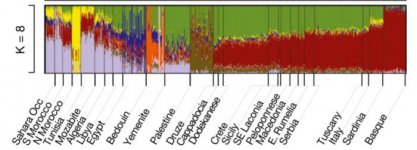@Boreas,
In case you missed it I've said numerous times in this thread that the only way to really know what happened is to compare the ancient dna of the people living in the Peloponnesus, all of Greece really, prior to the Slavic migrations and then afterwards, or to compare the ancient dna of people from these "Slavic" tribes to the dna of these ancient Greeks.
Since we don't have it yet, or these authors didn't have it when they did the paper, they used modern Poles and other Slavs as a proxy. It's not a great proxy, granted, but would a comparison with "South Slavs" have really been better? I don't know. A comparison with the modern day people of the northern Balkans would have been interesting, but since they already shared so much ancestry with the Greeks pre-the-Slavic migration era, would a comparison tell us how many nominally Slavic or Slavic speaking tribes moved into the Peloponnesus? I don't doubt that some did migrate, btw. I guess part of the confusion for historians and geneticists alike is that the "South Slavs" are not really "Slavs" genetically. If I had to guess I'd say that component is less than 50%. Perhaps part of the resistance to this paper is that some groups don't want to find out how little actual "Slav" is in them as well.
Looking at yDna would be another way of getting a handle on it, but, as I said, the total numbers of R1a and I2a in the Peloponnesus are very small, and the more likely to be specifically "Slavic" clades would, I think, be smaller yet. Did they carry stealth yDna or something? The levels in the northern Balkans are more respectable, so maybe that kind of comparison would be helpful. Does anyone have that data at their fingertips?
With reference to yDna, E-V13 is still around 40% or more in the Peloponnesus, and my understanding is that the papers which found those numbers did not test Albanians. So, how does that compare to the E-V13 in the areas in the northern Balkans from which any well mixed, nominally "Slavic" tribes would have come?
Laberia: What we can understand from this study is that it seems there has never been a Slavic invasion of Greece.
That's a straw man argument. Do you think you're on Eurogenes or something?

@Nik,
Sorry, but I think that's a total misreading of Sikeliot's point. This is what he said, to quote him verbatim:
Oreo Cookie: See my post above. They moved many Greek-speaking Sicilians, Calabrese, and Cretans to the Peloponnese to restore and solidify its Greek character. I attribute much of the similarity in the populations today to this.
That is
not what his supposed source actually said, even if that source were reliable, which it isn't. It said that
Greeks from Patras went to Sicily and then returned. Did you even read my post pointing all of this out? His conclusion is also completely different from the much more nuanced, sensible comment you're making.
I actually have stated, repeatedly, that the gene flow explaining similarities between Greeks and Italians went both ways and can't be attributed to one event, although it's clear that a lot of the gene flow went from Greece to Italy in many periods of history. Now, let's get back to the Greeks. As much as Sikeliot would like to make this about the Sicilians or southern Italians, it isn't.
It is amazing to me how well documented historical movements through archaeology like Greek colonization of southern Italy can be ignored or downplayed in favor of totally unreliable speculations based on absolutely nothing if it suits a certain agenda or national myth.
Also, again, please, no straw man arguments.
Ed. One of the things that has to be kept in mind is that the Greek cline has probably been created over thousands of years by differential gene flows from both the north and the south.
I found this lecture about Greek colonization interesting. Much of northern Greece was actually colonized from further south in Greece. The professor also makes the point that in his view the "center" of Greece was the Aegean.
It's worth watching, I think, for anyone interested in this period of Greek history.
https://www.youtube.com/watch?v=0Z71ZmfYE08


